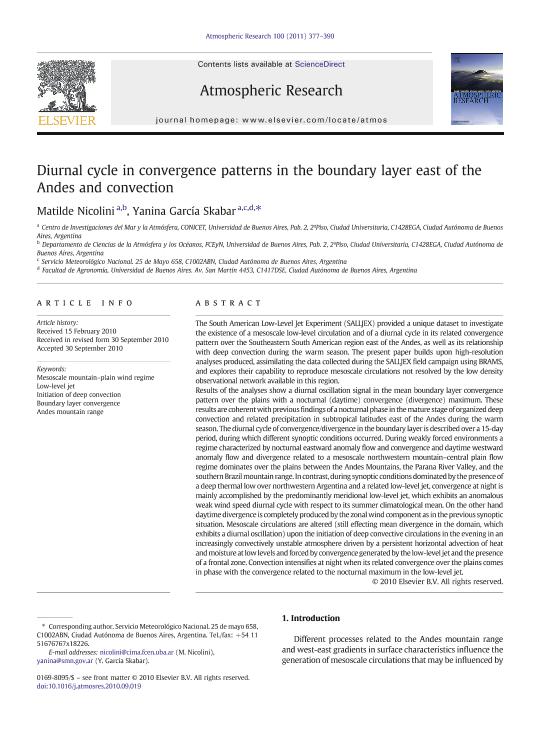Mostrar el registro sencillo del ítem
dc.contributor.author
Nicolini, Matilde

dc.contributor.author
Garcia Skabar, Yanina

dc.date.available
2019-01-28T17:16:40Z
dc.date.issued
2011-06
dc.identifier.citation
Nicolini, Matilde; Garcia Skabar, Yanina; Diurnal cycle in convergence patterns in the boundary layer east of the Andes and convection; Elsevier Science Inc; Atmospheric Research; 100; 4; 6-2011; 377-390
dc.identifier.issn
0169-8095
dc.identifier.uri
http://hdl.handle.net/11336/68739
dc.description.abstract
The South American Low-Level Jet Experiment (SALLJEX) provided a unique dataset to investigate the existence of a mesoscale low-level circulation and of a diurnal cycle in its related convergence pattern over the Southeastern South American region east of the Andes, as well as its relationship with deep convection during the warm season. The present paper builds upon high-resolution analyses produced, assimilating the data collected during the SALLJEX field campaign using BRAMS, and explores their capability to reproduce mesoscale circulations not resolved by the low density observational network available in this region. Results of the analyses show a diurnal oscillation signal in the mean boundary layer convergence pattern over the plains with a nocturnal (daytime) convergence (divergence) maximum. These results are coherent with previous findings of a nocturnal phase in the mature stage of organized deep convection and related precipitation in subtropical latitudes east of the Andes during the warm season. The diurnal cycle of convergence/divergence in the boundary layer is described over a 15-day period, during which different synoptic conditions occurred. During weakly forced environments a regime characterized by nocturnal eastward anomaly flow and convergence and daytime westward anomaly flow and divergence related to a mesoscale northwestern mountain-central plain flow regime dominates over the plains between the Andes Mountains, the Parana River Valley, and the southern Brazil mountain range. In contrast, during synoptic conditions dominated by the presence of a deep thermal low over northwestern Argentina and a related low-level jet, convergence at night is mainly accomplished by the predominantly meridional low-level jet, which exhibits an anomalous weak wind speed diurnal cycle with respect to its summer climatological mean. On the other hand daytime divergence is completely produced by the zonal wind component as in the previous synoptic situation. Mesoscale circulations are altered (still effecting mean divergence in the domain, which exhibits a diurnal oscillation) upon the initiation of deep convective circulations in the evening in an increasingly convectively unstable atmosphere driven by a persistent horizontal advection of heat and moisture at low levels and forced by convergence generated by the low-level jet and the presence of a frontal zone. Convection intensifies at night when its related convergence over the plains comes in phase with the convergence related to the nocturnal maximum in the low-level jet.
dc.format
application/pdf
dc.language.iso
eng
dc.publisher
Elsevier Science Inc

dc.rights
info:eu-repo/semantics/openAccess
dc.rights.uri
https://creativecommons.org/licenses/by-nc-nd/2.5/ar/
dc.subject
Andes Mountain Range
dc.subject
Boundary Layer Convergence
dc.subject
Initiation of Deep Convection
dc.subject
Low-Level Jet
dc.subject
Mesoscale Mountain-Plain Wind Regime
dc.subject.classification
Meteorología y Ciencias Atmosféricas

dc.subject.classification
Ciencias de la Tierra y relacionadas con el Medio Ambiente

dc.subject.classification
CIENCIAS NATURALES Y EXACTAS

dc.title
Diurnal cycle in convergence patterns in the boundary layer east of the Andes and convection
dc.type
info:eu-repo/semantics/article
dc.type
info:ar-repo/semantics/artículo
dc.type
info:eu-repo/semantics/publishedVersion
dc.date.updated
2019-01-25T13:43:16Z
dc.journal.volume
100
dc.journal.number
4
dc.journal.pagination
377-390
dc.journal.pais
Países Bajos

dc.journal.ciudad
Amsterdam
dc.description.fil
Fil: Nicolini, Matilde. Consejo Nacional de Investigaciones Científicas y Técnicas. Oficina de Coordinación Administrativa Ciudad Universitaria. Centro de Investigaciones del Mar y la Atmósfera. Universidad de Buenos Aires. Facultad de Ciencias Exactas y Naturales. Centro de Investigaciones del Mar y la Atmósfera; Argentina
dc.description.fil
Fil: Garcia Skabar, Yanina. Consejo Nacional de Investigaciones Científicas y Técnicas. Oficina de Coordinación Administrativa Ciudad Universitaria. Centro de Investigaciones del Mar y la Atmósfera. Universidad de Buenos Aires. Facultad de Ciencias Exactas y Naturales. Centro de Investigaciones del Mar y la Atmósfera; Argentina. Ministerio de Defensa. Secretaria de Planeamiento. Servicio Meteorológico Nacional; Argentina
dc.journal.title
Atmospheric Research

dc.relation.alternativeid
info:eu-repo/semantics/altIdentifier/doi/http://dx.doi.org/10.1016/j.atmosres.2010.09.019
dc.relation.alternativeid
info:eu-repo/semantics/altIdentifier/url/https://www.sciencedirect.com/science/article/pii/S0169809510002577
Archivos asociados
